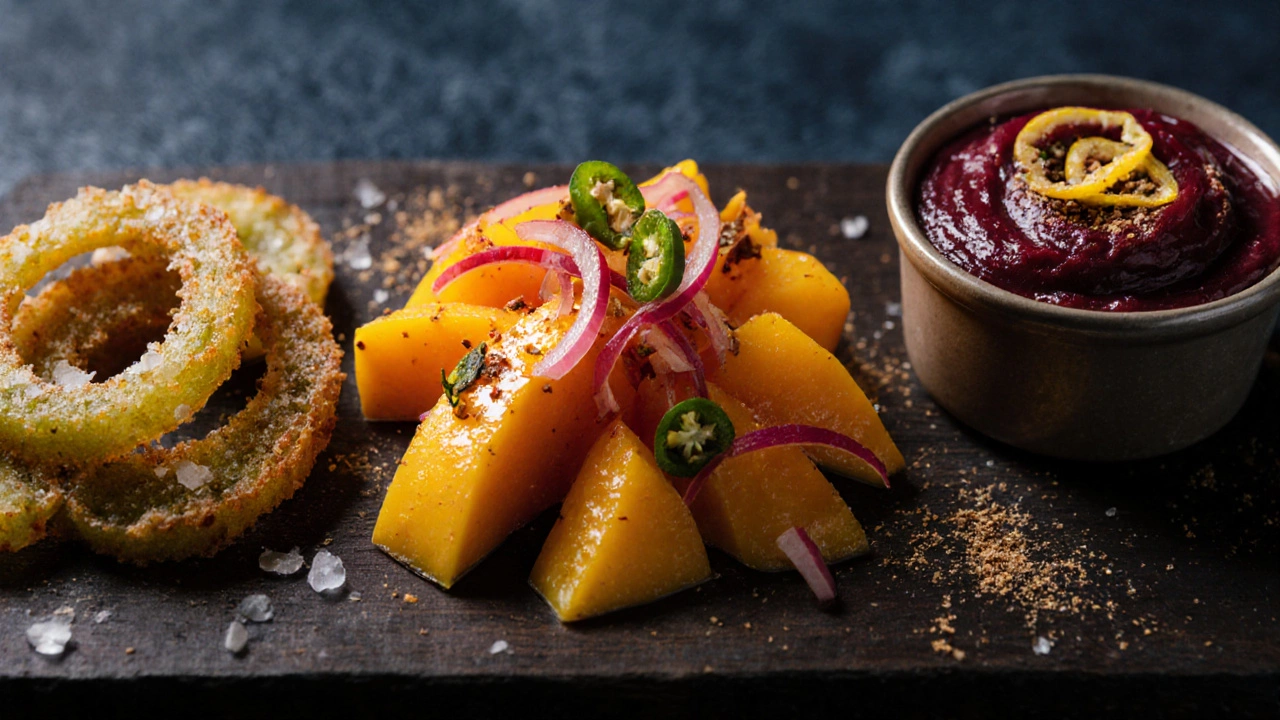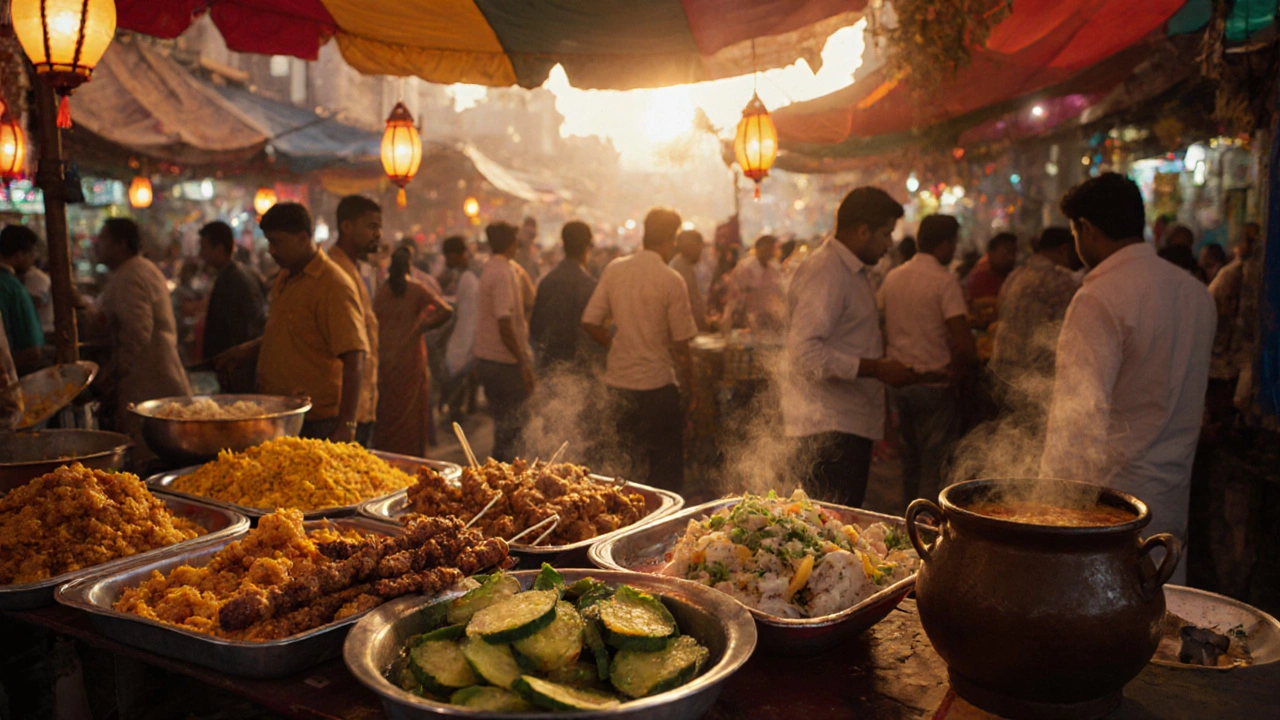Unpopular Indian Food Quiz
Bitter Gourd (Karela)
A green, ribbed fruit known for its intense bitterness that many find overpowering.
Intense bitternessRaw Mango Salad
Tart and astringent, this salad is often too sour for daily consumption.
Excessive sournessDrumstick Curry
Fibrous texture and slight bitterness make it unappealing to many.
Fibrous textureFermented Fish Curry
Pungent aroma that many find overwhelming and off-putting.
Pungent odorBeetroot Halwa
Earthy sweetness clashes with traditional Indian dessert flavors.
Earthy sweetness clashMoong Sprout Chaat
Bean-like smell can be off-putting, especially when raw.
Bean-y smellRaw Paneer
Bland and rubbery texture makes it unappealing compared to cooked versions.
Rubbery blandnessKokum
Sour and salty taste is unfamiliar to many Indian palates.
Unfamiliar tasteHow to Overcome Aversions
- Start small with new dishes
- Pair with familiar flavors
- Try different cooking methods
- Gradual exposure helps
Remember, culinary preferences evolve with experience and cultural exposure.
When you think of Indian cuisine, you probably picture sizzling curries, fragrant biryanis, and sweet jalebis. Yet, hidden behind the colorful spice racks are dishes that most Indians shy away from. If you’ve ever wondered which foods get the cold shoulder across the subcontinent, you’re about to find out.
unpopular Indian food isn’t a trendy label; it reflects real taste preferences gathered from street‑side polls, restaurant feedback, and social‑media chatter. Below we unpack the reasons behind the aversion and list the top contenders that rarely make it onto a family’s dinner table.
Why Some Dishes Fall Out of Favor
Indian cuisine is a tapestry of regional flavors, climate‑driven produce, and cultural rituals. What works in the humid kitchens of Kerala may feel off‑putting in the dry plains of Rajasthan. The main culprits behind dislike are:
- Bitter taste: Many Indian vegetables, like neem leaves or bitter gourd, carry a strong, lingering bitterness that the average palate finds harsh.
- Texture issues: Slimy or overly fibrous foods (think raw drumsticks or okra when overcooked) can be a turn‑off.
- Strong odor: Fermented fish, certain legumes, or aged cheeses emit scents that trigger a gag reflex.
- Unfamiliar ingredients: Dishes that use ingredients rarely seen in everyday cooking-such as beetroot in a curried form-can seem alien.
Socio‑economic factors also play a role. Some foods are linked to poverty or “poor‑man’s meals,” leading to a stigma that pushes them out of mainstream menus.
Top 7 Least‑Liked Indian Dishes (and Why)
1. Bitter Gourd (Karela) Stir‑Fry
Bitter gourd is a green, ribbed fruit that grows across India’s farms. Its name says it all-bitterness. Even when sliced thin and deep‑fried, the lingering after‑taste can dominate any seasoning. Many households either skip it or pair it with jaggery to mask the flavor, but the effort often doesn’t win over skeptics.
2. Raw Mango Salad (Kairi Ka Salad)
Unripe mangoes are tart, sour, and sometimes a bit astringent. When tossed raw with onions, chilies, and a squeeze of lemon, the salad can feel overly sharp. A 2023 food‑trend survey conducted by the Indian Culinary Institute found that 68% of respondents rated raw mango salads as “too sour for daily meals.”
3. Drumstick (Moringa) Curry
Drumstick refers to the long, slender pods of the moringa tree. While prized in South‑Indian sambar, its fibrous interior can feel stringy, and the slightly bitter after‑taste is not universally loved. Many North‑Indian diners label it as “weird texture.”
4. Fermented Fish Curry (Macha Tarkari)
In coastal Odisha and Bengal, fermented fish (known locally as “bhutua” or “paturi”) is a traditional protein source. The fermentation process produces a pungent aroma rivaling that of durian. A 2022 study by the National Institute of Nutrition recorded a 74% aversion rate among participants who had never grown up with the ingredient.
5. Beetroot Halwa
Beetroot is typically a savory staple, but when turned into a sweet halwa with ghee and sugar, it confuses many. The deep earthy flavor clashes with the expected richness of traditional Indian sweets like gulab jamun. Social‑media comments often describe it as “taste of dirt in a dessert.”
6. Green Gram Sprouts (Moong Bean Sprouts) Chaat
Sprouted moong beans are crunchy and nutritious, but raw sprouts can have a mild “bean‑y” smell that some find off‑putting. When crushed into a tangy‑spiced chaat, the scent amplifies, leading to a 60% dislike score in a Delhi‑based taste‑test.
7. Raw Paneer (Uncooked Cottage Cheese)
Paneer is usually cooked in gravies or grilled. Eating it raw, simply sliced and seasoned, can feel bland and rubbery. In a 2024 online poll, 55% of respondents said they would never choose raw paneer over its cooked counterparts.

What the Numbers Say
| Food | Primary Region | Typical Preparation | Most Cited Reason |
|---|---|---|---|
| Bitter Gourd (Karela) | All regions | Stir‑fry, stuffed | Intense bitterness |
| Raw Mango Salad | North India | Fresh slices with spices | Excessive sourness |
| Drumstick Curry | South India | Sambar, curry | Fibrous texture |
| Fermented Fish Curry | Coastal East India | Slow‑cooked in gravy | Pungent odor |
| Beetroot Halwa | Western India | Sugar‑infused sweet | Earthy sweetness clash |
| Moong Sprout Chaat | North & Central | Spiced raw sprouts | Bean‑y smell |
| Raw Paneer | Pan‑India | Sliced, seasoned | Rubbery blandness |
Can Perceptions Change?
Yes. Culinary trends and exposure can soften aversions. For instance, gourmet chefs in Mumbai have started serving “bitter‑gourd chips” with flavored salts, framing the bitterness as a desirable crunch. Similarly, fermented fish is now featured in upscale coastal restaurants where the aroma is paired with fragrant coconut milk, making it more approachable.
Travel also plays a role. A Delhi student who spent a semester in Kerala reported that repeated exposure to drumstick sambar turned the once‑odd texture into a nostalgic comfort. The key is incremental familiarity-adding a pinch of sweetness, a dash of acid, or a different cooking method can tip the balance.

Tips If You Want to Try an Unpopular Dish
- Start small: Order a half‑portion or share a plate with friends.
- Pair with familiar flavors: A bitter gourd stir‑fry tastes less harsh when paired with a sweet‑tangy tamarind dip.
- Adjust the cooking method: Roast bitter vegetables instead of deep‑frying to mellow the bitterness.
- Use accompaniments: A squeeze of lemon on raw mango salad can balance the sourness.
- Stay open‑minded: Remember that many beloved dishes were once considered odd.
Where to Find These Dishes
If you’re traveling across India, hit up regional street‑food hubs. In Kolkata, look for “Macha Tarkari” stalls near the Hooghly River. In Kerala’s Kasaragod district, family eateries often serve drumstick sambar with rice. For beetroot halwa, check out sweet shops in Gujarat during festive seasons.
Frequently Asked Questions
Why is bitter gourd so unpopular?
The primary reason is its strong, lingering bitterness. Even when cooked with spices, the bitter compounds remain, making it a challenging flavor for many Indian palates accustomed to richer, sweeter or spicier notes.
Can fermented fish become more acceptable?
Yes. When paired with creamy coconut milk or served in small tasting portions at upscale restaurants, the pungent aroma softens, allowing diners to appreciate its umami depth without being overwhelmed.
Is raw paneer unhealthy?
Nutritionally it’s fine-paneer provides protein and calcium. The dislike stems from texture and perceived blandness rather than any health risk.
How can I make beetroot halwa taste better?
Add a hint of cardamom, a splash of orange zest, or a drizzle of honey. These bright flavors cut through the earthiness and make the sweet more appealing to those used to traditional Indian desserts.
Are there regional variations that reduce the bitterness of karela?
Yes. In Gujarat, karela is often sliced thin, salted, rinsed, and then fried, which extracts some bitter compounds. In Bengal, it’s cooked with potatoes and a sweet‑sour tamarind sauce that balances the flavor.
